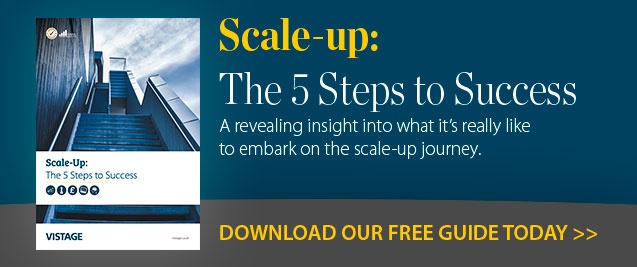
In many aspects of life, it helps to follow the instructions. That pile of planks, poles and allen keys isn’t going to make a wardrobe unless you know how it all fits together. Instructions give you a process by which to achieve your vision - and helps it stand up when you put it into practice.
But does the same apply to business?
Startups and scale-ups often have disruption at their core, Facebook’s original ‘move fast and break things’ motto being a prime example. The temptation is to go your own way, break with tradition, find new ways to do business - but the cognitive load involved can be overwhelming.
- You may like: Is technology the answer to your productivity problems?
In our experience, having a business leadership framework offers two main benefits. Firstly, a leadership framework means you don’t need to do all the research yourself - you can borrow best practice and make the necessary changes. Secondly, business frameworks offer a directorial perspective. Leaders work on the business, not in it. Their role is to define and implement a vision, not to micromanage the disruptions of the day.
We’re taking on five of the major frameworks on offer - the Lean Startup, the Startup Owner’s Manual, the Entrepreneurial Operating System (EOS), EMyth Coaching and the 4 Disciplines of Execution (4DX). Here’s how they stack up.
Lean Startup
Eric Ries’ Lean Startup principles are geared around getting the product into the customers’ hands as fast as possible, for as little cost as possible. Not everyone who has a great idea for a product or service has the mindset to bring it to market - Ries’ framework introduces core business decision-making to product-led thinkers.
Starting from correcting the very first question - moving from “can this be built?” to “can we build a sustainable business around this?” - Lean Startup treats the process of starting a business as one of learning by testing hypotheses. It uses a “five whys” interrogative structure to frame and process issues, pursuing a chain of causes and effects that establish the root of the problems people are experiencing. What can you change to address the issue? Test that change and see if it works.
Pros
- Encourages businesses to test and plan their offerings with the marketplace in mind
- Responds well to change and uncertainty in volatile fields, such as finance or SEO
- Fits well with the early stages of a business, when money is tight and time to market is vital
Cons
- Diminishing returns - too many tests and changes undermine founders’ confidence in the business
- Emphasises mindset, spend and return - but doesn’t provide substantive how-to structure
- Risks the team burning out on repeated redesigns, and often struggles to build deep products
Startup Owner’s Manual
Steve Blank’s The Startup Owner’s Manual bills itself as ‘the step by step guide for building a great company’. It’s a highly structured process, built around a business model canvas that encourages leaders to identify their key partners, activities and value propositions, and the potential customer segments that will bring in revenue.
The Manual isn’t exciting, but it’s technical and extensive. It emphasises customer discovery, validation and creation as the start of a business journey: not the idea for the offering, in other words, but the processes that will create a viable and profitable business. Each of these processes is modelled in depth, and it’s recommended to complete them one channel at a time, to ensure that you’ve seen your growth plan through.
Pros
- Exhaustively detailed - a checklist-based model of development for your business
- Provides clear distinction between web/mobile businesses and bricks and mortar, highlighting the different challenges involved
Cons
- Focused on the product and the market - pays limited attention to competition, risks or category
- All business - limited value in terms of mindset, product issue processing or workplace culture
The EMyth Coaching Program
EMyth is short for Entrepreneurial Myth - the mistaken belief that people who start businesses are entrepreneurs, and that people who understand what the business does can successfully run it. Michael E. Gerber’s book sets out that claim, and has since blossomed into an international business development consultancy.
EMyth’s method is all about mentorship - your business works with a certified coach who will challenge you to make decisions from a directorial perspective, working on the business rather than in it. Together, you develop a vision for the next three years and establish goals for the longer term. That vision will feed into a values statement which expresses your values in concrete terms - what your business will look like, how it will work, what market segments it will target and, of course, what its financial results will be.
Pros
- Developmental structure - retrains product innovators into business directors
- Based on direct relationships between professionals
- Holistic focus - emphasises values as embodied in your business’ day to day operations
Cons
- Nobody completes EMyth - that would end the cash flow from a paying customer.
- Accused of McDonaldisation - reducing business growth to a one-size-fits-all model composed of repetitive, routine tasks
- Employee reviews suggest EMyth doesn’t follow its own advice, lacking a coherent overall strategy for its own affairs
Entrepreneur Operating System (EOS)
As the name suggests, EOS provides a structure in which your products, services and operations can function.
Quarterly meetings set ‘rocks’ - the immovable objectives toward which the business is moving - and make sure everyone in the business is responsible for achieving one of them. Weekly ‘Level 10’ meetings among the leadership team focus on processing and resolving issues, with strict timers to ensure resolution is understood within an hour.
Beyond this, EOS encourages you to use an Implementer - an expert advisor who can help offering-focused entrepreneurs develop the structure of their business, and provide an outside opinion on crisis points like personnel changes or mid-quarter pivots.
Pros
- Ideal for fast moving and creative businesses which can end up lost in the day to day.
- Blends approaches: reactive and strategic, day to day operations and long term vision
- Restructures businesses with existing bad habits
Cons
- Successfully implementing EOS means committing to a particular mindset - not every business leader has the right priorities
- A daunting prospect for smaller organisations - especially if some members need to be exited, or new hires made, to put the right people in the leadership team
Four Disciplines (4DX)
4DX is structured, as you might expect, around four disciplines - focus, leverage, engagement and accountability. The system, pioneered by Chris McChesney and Sean Covey, introduces these disciplines into businesses where they are currently lacking, without sacrificing the existing business’ objectives or culture.
The 4DX approach sets one Wildly Important Goal for the business as a whole, and everyone’s responsibilities are built around executing that goal. Issue processing along the way is centralised, reactive and inclusive, setting a weekly meeting with everyone and checking on how they’re doing, relating their performance back to a compelling scoreboard with consequences for failure or success.
Pros
- Solves a specific problem: businesses which have a vision, but struggle to implement it
- Usable from day one, and adaptable to different company cultures
Cons
- Another one size fits all approach - hyperfocusing one goal may not work for every team
- Calls and meetings about goals distract from operations - and some managers begin fabricating results to avoid them
Like most things in business, leadership frameworks can be useful. They all encourage changing your business culture, finding a perspective that’s removed from the day to day so you can make the significant decisions that are only possible at leadership level.
At their worst they can become a drain on time (all those meetings), money (all those consultancy fees) and morale (pushing profitability over product innovation).
To successfully roll out any of these frameworks, you need to understand clearly what you want and need to achieve - and have a metric of success so you know it’s working.

